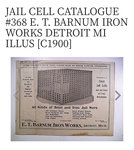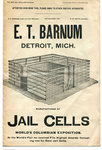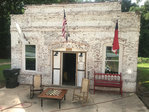






If you’ve had a chance to drive through Twin City on North Railroad Avenue, you may have noticed a quaint historical building coming back to life. In the city charter and records of the merging of Graymont and Summit, this beautiful brick structure is depicted as the “calaboose.” Most in town refer to it as “the old city jail” or “old city hall.” One of Twin City’s senior residents and great storytellers, John Turner, will regale you with stories of an escape at the old jail. He tells the story vividly of two men overpowering a Twin City police officer he names as “Coot,” who was shot in the leg during the incident.
During the ongoing restoration of this historic setting, a small metal, almost completely rusted over, and illegible label was discovered. A bit of cleaning revealed that the cells were manufactured by the E.T. Barnum Iron Works in Detroit, Michigan. A wee bit of research into this company revealed an illustrious history throughout the U.S. as well as an infamous dark historical caveat of the history of jails and corrections in our county. The internet is replete with information about this company and one unique product, jail cells. An advertisement for the company lists cities throughout America using this product for their “lock-ups.” Statesboro and Dublin appear in their advertising.
Historical societies in many cities describe their use of the E.T. Barnum jail cells. The product was touted as being a large part of the westward expansion in U.S. small cities and counties throughout Kansas. So, when and how did these “cages,” complete with double hinged bunks and an opening for food trays, find their way to Twin City?
The cramped ominous and cold appearance is a bit frightening. One of the company’s advertisements suggest that their product would increase morals and reduce crime, perhaps.
The cells located in Twin City are being restored right down to the double bunks for display-only purposes for visitors to enjoy a recollection of history.
From Detroit to Kansas to other cities throughout the country, there is connection and history, dark as it may be, when looking at these cells.
On a lighter note, a citizen curious about the old jail made a recent visit just to see if the cells were still present. While visiting, the individual recalled a bit fondness of memory regarding a family member of theirs who had a proclivity to imbibe spending some quality time there and laughed about frequent trips made to the old jail to retrieve the family member. It was reported that there seemed to be some connection with that particular family member, who is now passed away, just knowing that the cells are still there.